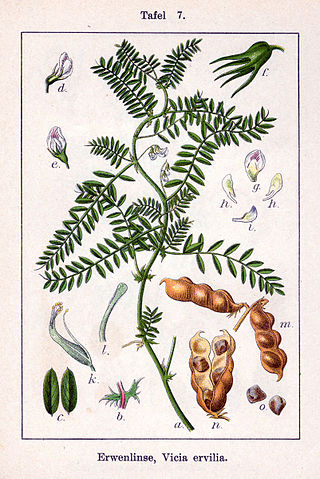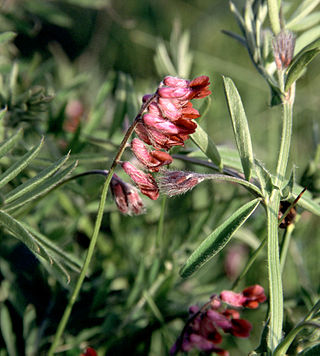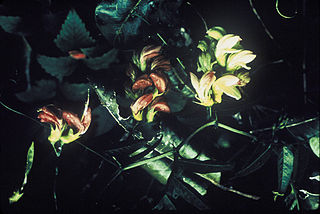
Vicia sativa, known as the common vetch, garden vetch, tare or simply vetch, is a nitrogen-fixing leguminous plant in the family Fabaceae. It is likely native to North Africa, Western Asia and Europe, but is now naturalized in temperate and subtropical regions worldwide. Although considered a weed when found growing in a cultivated grainfield, this hardy plant is often grown as a green manure, livestock fodder or rotation crop. More than 500,000 hectares per year of Vicia sativa is grown in Australia.

Vicia cracca, is a species of flowering plant in the pea and bean family Fabaceae. It is native to Europe and Asia. It occurs on other continents as an introduced species, including North America, where it is a common weed. It often occurs in disturbed habitats, including old fields and roadside ditches.

Vicia is a genus of over 240 species of flowering plants that are part of the legume family (Fabaceae), and which are commonly known as vetches. Member species are native to Europe, North America, South America, Asia and Africa. Some other genera of their subfamily Faboideae also have names containing "vetch", for example the vetchlings (Lathyrus) or the milk-vetches (Astragalus). The broad bean is sometimes separated in a monotypic genus Faba; although not often used today, it is of historical importance in plant taxonomy as the namesake of the order Fabales, the Fabaceae and the Faboideae. The tribe Vicieae in which the vetches are placed is named after the genus' current name. Among the closest living relatives of vetches are the lentils (Lens) and the true peas (Pisum).

Vicia ervilia, called ervil or bitter vetch, is an ancient legume crop of the Mediterranean region. Besides the English names, other common names include: gavdaneh (Persian), kersannah (Arabic), yero (Spanish), rovi (Greek), and burçak (Turkish). The nutritional value of the grain for ruminant cattle has guaranteed the species' continued cultivation in Morocco, Spain and Turkey. The crop is easy to cultivate and harvest and can be grown on very shallow, alkaline soils.

Vicia villosa, known as the hairy vetch, fodder vetch or winter vetch, is a plant native to some of Europe and western Asia. It is a legume, grown as a forage crop, fodder crop, cover crop, and green manure. Although non-native, it occurs in all US states and is considered invasive by some states, such as Alaska, Florida, Georgia, Kansas, Michigan, Minnesota, Oregon, and Washington state — as well as in Japan and some parts of Europe where it is not native. It is also found in most Canadian provinces.

Vicia tetrasperma the smooth tare, smooth vetch, lentil vetch or sparrow vetch, is a species of flowering plant in the bean family Fabaceae. It can be invasive.

Vicia sepium or bush vetch is a species of flowering plant in the pea and bean family Fabaceae. A nitrogen-fixing, perennial, leguminous climbing plant that grows in hedgerows, grasslands, the edges of woodland, roadsides and rough ground. It occurs in western Europe, Russia including Siberia, Crimea, Caucasus and Central Asia. It can also be found in eastern Canada, north-eastern states of the USA and, where suitable habitat occurs, in Greenland. It is native to, and has been recorded in, almost all parts of Britain, Ireland and associated islands.

Vicia sylvatica, known as wood vetch, is a species of flowering plant in the bean family Fabaceae. It was described by Carl Linnaeus.

Vicia americana is a species of legume in the vetch genus known by the common names American vetch and purple vetch. It includes a subspecies known as mat vetch.

Grindelia stricta is a species of flowering plant in the family Asteraceae known by the common names Oregon gumplant, Oregon gumweed and coastal gumplant. It is native to the west coast of North America from California to Alaska, where it is a resident of coastal plant communities such as those in marshes and beaches. This plant is variable in appearance, taking the form of a weedlike perennial herb forming low clumps to a sprawling subshrub growing erect to heights exceeding one meter. Its foliage and stems are green to rusty red or purplish and the plant may be hairy to hairless. The fleshy leaves are green, often with red edges and veining, and are up to 15 centimeters in length on large plants. The inflorescence holds one or more flower heads each up to 5 centimeters wide. The flower head is a cup of thick erect or recurved green phyllaries. Yellow disc florets fill the center of the flower head and there is a fringe of yellow ray florets around the circumference. The head produces copious amounts of white latex, especially in the early stages of blooming.

Herniaria hirsuta is a species of flowering plant in the family Caryophyllaceae known by the common name hairy rupturewort. It is native to Eurasia and North Africa, and it is known on other continents, including North America, as an introduced species. This is an annual herb with stems up to 20 cm (8 in) long usually growing prostrate along the ground. The small, fuzzy, pale green leaves are up to about a centimeter long and coat the stems. The inflorescences appear in the leaf axils. Each contains three to eight hairy green sepals and no petals. The fruit is a tiny bumpy utricle containing one seed.

Silene noctiflora is a species of flowering plant in the family Caryophyllaceae known by the common names night-flowering catchfly, nightflowering silene and clammy cockle. It is native to Eurasia, but it is known on other continents as an introduced species and sometimes a weed. In North America, it is a common weed of grain crops in the Canadian prairie provinces and in much of the United States. It grows in fields and in other disturbed habitat.

Lathyrus linifolius is a species of pea, commonly called bitter vetch or heath pea. The name bitter vetch is also sometimes used for Vicia ervilia and also for Vicia orobus. The tubers of Lathyrus linifolius were formerly used as an appetite suppressant in medieval Scotland, and this use has brought the plant to recent medical attention. Attempts are being made to cultivate the plant on a commercial scale.

Vicia benghalensis is a species of vetch known by the common names purple vetch and reddish tufted vetch. It is native to southern Europe, North Africa, and nearby islands, and it is utilized elsewhere in agriculture and may be present in the wild as an introduced species. It is an annual herb with a climbing stem which is coated in hairs, often densely, making the plant appear silvery white. Each leaf is made up of several pairs of elongated leaflets which measure up to 3 centimeters in length. The inflorescence is a one-side raceme of several dark reddish purple flowers. Each flower has a densely hairy calyx of sepals and a tubular corolla between one and two centimeters in length. The fruit is a flat, hairy legume pod up to 3.5 centimeters long containing multiple seeds.

Vicia nigricans is a species of vetch known by the common name black vetch. It has a disjunct distribution, its two subspecies divided by thousands of miles in range. The northern subspecies, ssp. gigantea, is native to western North America from Alaska to northern California, where it occurs in coastal and moist inland habitat and disturbed areas. The southern subspecies, ssp. nigricans, occurs in southern South America, in Argentina and Chile.

Vicia hassei is a species of vetch known by the common names Hasse's vetch and slender vetch.

Vicia pannonica is a species of vetch known by the common name Hungarian vetch. It is native to southern, central Europe and western Asia, and it is sometimes cultivated as an agricultural crop for use as hay and fodder. It may escape cultivation and grow as a casual roadside weed.

Vicia menziesii is a rare species of flowering plant in the legume family known by the common name Hawaiian vetch. It is endemic to Hawaii, where it is known only from the island of Hawaii. It is threatened by habitat loss and exotic plants. It has been federally listed as an endangered species of the United States since 1978. It was the first Hawaiian plant to be placed on the Endangered Species List.

Vicia bithynica known as Bithynian vetch, is a species of flowering plant in the bean family Fabaceae. It was described by Carl Linnaeus, initially as Lathyrus bithynicus but later moved to the genus Vicia (vetches). The specific name is derived from Bithynia, an ancient kingdom situated on the north coast of Anatolia, in modern day Turkey.
Wild tare or tare is the name given to several flowering plants of the pea family (Fabaceae), of the genus Vicia, or 'vetch', hence they look very similar to the vetches in the same genus. These plants are found in Britain and northern Europe and have flowers ranging from pale to deep lilac in colour. Three species found in Britain are hairy tare, smooth tare, and slender tare.



















